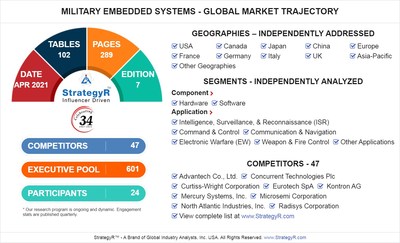TMCnet News
Global Military Embedded Systems Market to Reach $161.6 Billion by 2026SAN FRANCISCO, Aug. 5, 2021 /PRNewswire/ -- A new market study published by Global Industry Analysts Inc., (GIA) the premier market research company, today released its report titled "Military Embedded Systems - Global Market Trajectory & Analytics". The report presents fresh perspectives on opportunities and challenges in a significantly transformed post COVID-19 marketplace. FACTS AT A GLANCE Complimentary Project Preview - This is an ongoing global program. Preview our research program before you make a purchase decision. We are offering a complimentary access to qualified executives driving strategy, business development, sales & marketing, and product management roles at featured companies. Previews provide deep insider access to business trends; competitive brands; domain expert profiles; and market data templates and much more. You may also build your own bespoke report using our MarketGlass™ Platform which offers thousands of data bytes without an obligation to purchase our report. Preview Registry ABSTRACT- Global Military Embedded Systems Market to Reach $161.6 Billion by 2026 Land, naval, space and airborne are the different platforms in which military embedded systems are used, with the land segment accounting for a major share owing to growing need for surveillance. There are different server architectures for military embedded systems but the most desired currently is the bade server architecture due to its increasing adoption in network centric avionics and military applications that necessitate higher end computing with increased input/output than what is possible with standard servers. Advanced blade servers also emerged, adoption of which is rapidly growing in the present scenario, especially for military applications that are network-centric. Amid the COVID-19 crisis, the global market for Military Embedded Systems estimated at US$100.5 Billion in the year 2020, is projected to reach a revised size of US$161.6 Billion by 2026, growing at a CAGR of 8.3% over the analysis period. Hardware, one of the segments analyzed in the report, is projected to grow at a 7.8% CAGR to reach US$111.3 Billion by the end of the analysis period. After a thorough analysis of the business implications of the pandemic and its induced economic crisis, growth in the Software segment is readjusted to a revised 9.1% CAGR for the next 7-year period. This segment currently accounts for a 34.7% share of the global Military Embedded Systems market. The U.S. Market is Estimated at $44.3 Billion in 2021, While China is Forecast to Reach $21.1 Million by 2026 Increasing expenditure of governments on strengthening respective military sectors is creating strong demand for military embedded systems. However, cloud computing, wireless technologies and multi-core processors and such other technological advancements are anticipated to disrupt the market for military embedded systems over the years ahead. Governments are also investing in research for developing more advanced embedded systems, which is also a market growth promoting factor. Nonetheless, embedded systems for military applications must be more secure than those used by civilians. The systems must be able to prevent data interception and reverse engineering and designed to perform in the harsh battlefield conditions. Components used in the systems must also be sourced from trusted entities for preventing any unsanctioned software entering into the devices. There is a strong growing demand for multicore technologies employed in modern warfare. Demand had also increased for network centric warfare systems, wireless technologies and cloud computing which is driving the military embedded systems market worldwide. Other growth promoting factors include increasing focus of militaries worldwide on wireless technologies and cloud computing, rising military expenditure of developing countries in the East, and growing number of terrorism incidents among others. Increasing use of lightweight vehicles, smart wearables, and soldier's smartphones are also creating ample demand growth opportunities for embedded systems in the military sector. Growing demand for lightweight and fuel efficient aircraft and other sophisticated combat systems also contribute to market growth. Market growth however, may be restricted by stringent regulations governing use of embedded devices. Rules pertaining to designing of the products are also stringent, which holds the potential to restrict anticipated growth for the market to a certain extent. Increasing complexities in development of embedded products, stringent security procedures and strict requirements for securing certifications for designs are also the factors restraining market growth. Development of compact embedded systems is becoming challenging by the day. The systems are being required to fit into different portable platforms used for military applications. The size of embedded systems is currently inversely proportional to the number of applications they have come to support. Skilled designers are the need of the hour for designing such complex embedded systems. Quality of code is also important for embedded systems, especially for those employed for security and safety-oriented applications in avionics. Constant upgradation of electronics used in military applications necessitates advancements in embedded systems as well. Designers are required to create components that consume less power and which are smaller in size, which also increased design complexity for embedded system. By Application, Command & Control Segment to Reach $32 Billion by 2026 MarketGlass™ Platform Our platform is free for qualified executives and is accessible from our website www.StrategyR.com or via our just released mobile application on iOS or Android. About Global Industry Analysts, Inc. & StrategyR™ CONTACTS: LINKS
SOURCE Global Industry Analysts, Inc. 
|

